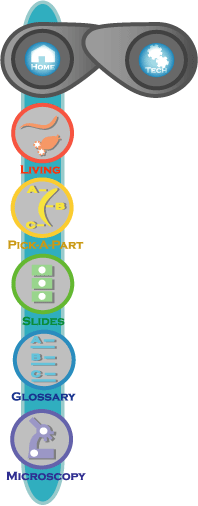
Nervous System
The most prominent features of the nervous system typically visible with the compound microscope are the nerve ring and several sensory organs (C). The nerve ring appears as light colored transverse fibers (nerve processes) surrounding the pharynx at the isthmus or equivalent region.
Although sensory organs (sensilla) can occur any where on the body, and they can be expressed in a wide range of structures, they are especially abundant in the head and tail region (A, D). A typical pattern in the head region includes, near the stoma opening, a circle of six inner labial sensilla, a second circle of six outer labial sensilla, and four cephalic sensilla. Sensilla on the head region and elsewhere may be expressed as small bump-like elevations, papillae, that may or may not open to the exterior, or they may be expressed as elongate hair-like structures, setae (A). In addition, the head region includes openings of two amphid sensory organs; these open on each lateral side (A). Although the amphid opening often is a simple pore or slit, in some nematodes it is a large concave circle, curved slit, or spiral trench. Some nematodes also have a pair of deirids, small papilla-like sensory organs on each lateral side posterior to the nerve ring (C). Rarely pigmented lateral organs, ocelli, occur beneath the surface on the lateral sides near the anterior end of the pharynx (C)
The tail is often rich in sensilla and many nematodes have a pair of lateral sensory organs, phasmids, in this region. Males of many nematodes have an array of papillae on the tail, and where these occur in conjunction with caudal alae (bursa), they may be associated with elongate rays (D).
